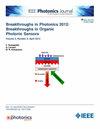Meijer-G Function With Continued Product and Integer Exponent: Performance of Multi-Aperture UOWC System Over EGG Turbulence
IF 2.1
4区 工程技术
Q3 ENGINEERING, ELECTRICAL & ELECTRONIC
引用次数: 0
Abstract
Signal transmission over underwater optical wireless communication (UOWC) experiences the combined effect of oceanic turbulence and pointing errors statistically modeled using the sum of two Meijer-G functions. There is a research gap in the exact statistical analysis of multi-aperture UOWC systems that use selection combining diversity techniques to enhance performance compared to single-aperture systems. In this paper, we develop a general framework for the continued product and positive integer exponent for the sum of Meijer-G functions to analyze the exact statistical performance of the UOWC system in terms of multivariate Fox-H function for both independent and non-identically distributed (i.ni.d.) and independent and identically distributed (i.i.d.) channels. We also approximate the performance of a multi-aperture UOWC system with i.i.d. channels using the single-variate Fox-H function. Using the generalized approach, we present analytical expressions for average bit-error rate (BER) and ergodic capacity for the considered system operating over exponential–generalized gamma (EGG) oceanic turbulence combined with zero-boresight pointing errors. We also develop asymptotic expressions for the average BER at a high signal-to-noise (SNR) to capture insights into the system's performance. Our simulation findings confirm the accuracy of our derived expressions and illustrate the impact of turbulence parameters for i.ni.d. and i.i.d. models for the average BER and ergodic capacity, which may provide a better estimate for the efficient deployment of UOWC.求助全文
约1分钟内获得全文
求助全文
来源期刊

IEEE Photonics Journal
ENGINEERING, ELECTRICAL & ELECTRONIC-OPTICS
CiteScore
4.50
自引率
8.30%
发文量
489
审稿时长
1.4 months
期刊介绍:
Breakthroughs in the generation of light and in its control and utilization have given rise to the field of Photonics, a rapidly expanding area of science and technology with major technological and economic impact. Photonics integrates quantum electronics and optics to accelerate progress in the generation of novel photon sources and in their utilization in emerging applications at the micro and nano scales spanning from the far-infrared/THz to the x-ray region of the electromagnetic spectrum. IEEE Photonics Journal is an online-only journal dedicated to the rapid disclosure of top-quality peer-reviewed research at the forefront of all areas of photonics. Contributions addressing issues ranging from fundamental understanding to emerging technologies and applications are within the scope of the Journal. The Journal includes topics in: Photon sources from far infrared to X-rays, Photonics materials and engineered photonic structures, Integrated optics and optoelectronic, Ultrafast, attosecond, high field and short wavelength photonics, Biophotonics, including DNA photonics, Nanophotonics, Magnetophotonics, Fundamentals of light propagation and interaction; nonlinear effects, Optical data storage, Fiber optics and optical communications devices, systems, and technologies, Micro Opto Electro Mechanical Systems (MOEMS), Microwave photonics, Optical Sensors.
 求助内容:
求助内容: 应助结果提醒方式:
应助结果提醒方式:


